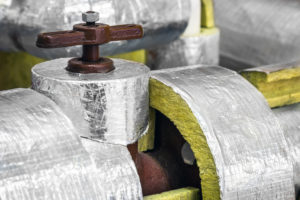Industrial Heating System Insulation Materials
Last updated on June 18th, 2021 at 07:17 pm
 Industrial heating systems offer more profitable processes when they operate at high efficiency and minimize heat loss. For both of these factors, proper insulation can have a significant impact. A well-insulated heating system is a more profitable one.
Industrial heating systems offer more profitable processes when they operate at high efficiency and minimize heat loss. For both of these factors, proper insulation can have a significant impact. A well-insulated heating system is a more profitable one.
Importance of Insulation
Insulation is a passive tool that has a significant impact on the operational costs and efficiency of industrial heater systems. Without insulation, heat loss averages to 35%-45%, whereas with insulation this dorps to 5%. Minimizing heat loss has multiple benefits.
The first is that minimizing heat loss protects the integrity of the product. Serving important functions like freeze protection. Insulation is your first line of defence against sudden temperature drops. Although an electric heater is still important to react to external temperature drops, the insulation prevents product temperatures from dropping too much before the heater can bring the product back up to the target temperature. Products that freeze may stop processes or lose their quality or viability.
As well, insulation prevents unexpected temperature drops that can alter the flow rate. If too much heat is lost the flow rate can decrease, resulting in a loss of productivity and putting extra strain on the heating system.
Finally, the better your insulation, the lower your heating costs. By reducing heat loss, you have less need to add heat artificially. The heat falls out of the target range less frequently and to a lesser degree. As a result, the heaters do not need to operate as often or for as long. This saves on operational costs, using less power and increasing the longevity of your heater.
Insulation Materials
Blanket Insulation
Blanket insulation comes in continuous rolls that can be cut to fit the exact space required. It is composed of small fibers. This is one of the most recognizable types of insulation, with fiberglass blanket insulation typically being used in homes.
Microporous
Microporous blanket insulation is highly efficient. Although it’s typical thickness is ≤10mm, it offers equal insulation to other materials of greater thickness. As such, they are ideal in application with limited space.
Despite it’s thinner blanket, this material is still effective in applications up to 650℃ (1200℉). It is a hydrophobic material, making it less prone to rot and water damage.
Silica Aerogel
Silica aerogel is another thin hydrophobic blanket insulation material. Although it has similar characteristics to microporous insulation, they operate best at different temperatures. Silica aerogel insulation performs better temperatures below 95°C (200℉).
At higher temperatures, this material experiences thermal shift, which degrades its performance. As such, microporous insulation is preferable for higher temperature operations.
Rigid Insulation
Rigid insulation is generally thicker than blankets. It can reduce gaps and air leaks to provide greater insulation, but it takes up more space.
Calcium Silicate
Calcium silicate insulation is good for high heat, acceptable for use in applications up to 650℃ (1200℉). It is a strong material that is ideal for use where there is potential exposure to impact or environmental hazards. This material can be made to have corrosion and water resistant properties.
Expanded Perlite
Also acceptable for use in applications up to 650℃ (1200℉), expanded perlite is more brittle, and has less strength than calcium silicate insulation. However, it has hydrophobic properties and can have corrosion inhibiting properties. As such, it is ideal for use where corrosion and water exposure are likely.
PIR
Polyisocyanurate (PIR) is another rigid insulation material with hydrophobic properties. However, it is not appropriate for use in high temperature applications. Typical use should not go above 150℃ (300℉).
PIR is best suited for applications that have hot and cold cycles, such as LNG. Although it is not a material built for high temperatures, it is acceptable for cryogenic applications.
Mineral Wool
Mineral wool insulation comes in many forms including rigid, board, and blanket insulation. Because it is a lightweight material, mineral wool insulation is usually used where weight is an important consideration. As well, it has a low cost and provides significant noise control.
Although it is listed as acceptable for applications up to 650℃ (1200℉), the binding agent may start to deteriorate at temperatures above 205℃ (400℉).
Choosing the Right Insulation for Your Heating System
Just as choosing the right heater materials will affect the efficiency and lifespan of your heating system, so can selecting the right insulation type. The operating environment, exposure, and temperature of your industrial heating system can impact what type of material is right for your project.
At Wattco, our engineers can aid in selecting the right materials and configurations to get the most out of your custom-manufactured heating solution.
